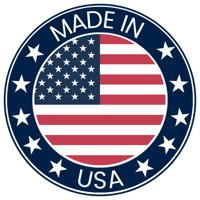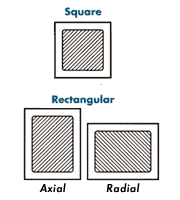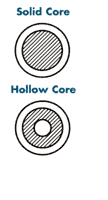Technical Specifications
Elastomeric Core Options
- Solid silicone to ZZ-R-765 CLASS 2B/70 DURO-FDA Compliant
- Hollow silicone to ZZ-R-765 CLASS 2B/70 DURO-FDA Compliant
- Viton™ (75 DURO) to AMS 3216 (formerly MIL-R-83248C)
- EPDM 70 DURO-FDA Compliant
Elastomeric Core Options
FEP (Fluorinated Ethylene Propylene)
- Clear
- Upper temperature limit: 400°F (204°C)
- Excellent chemical and corrosion resistance
- Will not absorb moisture
- Excellent resilience
- Smooth/self-lubricating surface
- FDA Compliant
- USP Class VI approved
PFA (Perfluoroalkoxy)
- Clear with light blue tint
- Upper temperature limit: 500°F (260°C)
- Excellent heat and chemical resistance
- Better crack and stress resistance than FEP
- Extremely smooth surface
- Low vapor permeation
- FDA Compliant
- USP Class VI approved
Encapsulation wall thickness ranges from .010" (0.25mm) to 0.45" (1.14mm) depending on the cross section of the elastomeric core.
Temperature Range
| FEP | PFA | |
|---|---|---|
| Silicone | -75° to +400°F -60° to +205°C |
-75° to +500°F -60° to +260°C |
| Viton™ | -15° to +400°F -26° to +205°C |
-15° to +400°F -26° to +205°C |
| EPDM | -65° to +300°F -54° to +150°C | -65° to +300°F -54° to +150°C |
Characteristics of Encapsulated O-Ring Core Material
EPDM
- General temperature range: -65° to +300°F (-54° to +150°C)
- Good weather aging and ozone resistance
- Excellent water & steam resistance
- Good chemical resistance to many organic and inorganic acids and many polar solvents such as alcohols, ketones, and esters
Silicone
- General temperature range: -67° to +500°F (-55° to +260°C)
- Low compression set
- Good heat resistance
- Good low temperature resistance
- Moderate solvent resistance
- Ozone aging & weather resistance
Viton™
- General temperature range: -15° to +400°F (-26° to +205°C)
- Low compression set at elevated temperatures
- Good ozone, weather and aging resistance
- High heat resistance
- Good for wide range of oils & solvents, such as aliphatic, aromatic & halogenated hydrocarbons, and vegetable oils
Acids - Low out gassing
Design Tip! Basically these three compounds are used as a spring inside of FEP or PFA encapsulation. Some chemicals are absorbed over time by FEP and PFA and permeate to the core. In that case care should be taken to select core material that is most compatible with the chemicals involved.
Design Recommendation Disclaimer:
Recommendations on application design and material selection are based upon available technical data and are offered as suggestions only. Each user should conduct evaluations to determine the suitability for his particular application. ROW, Inc. offers no express or implied warranties concerning the form, fit, or function of a product in any application.

![5[1] 5[1]](https://row-inc.com/hs-fs/hubfs/5%5B1%5D.png?width=200&height=200&name=5%5B1%5D.png)

